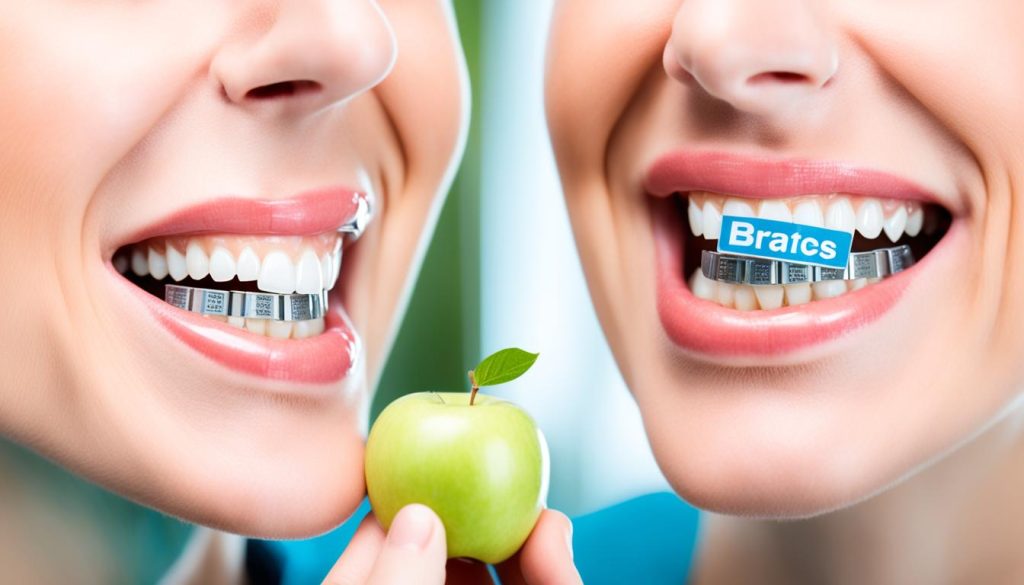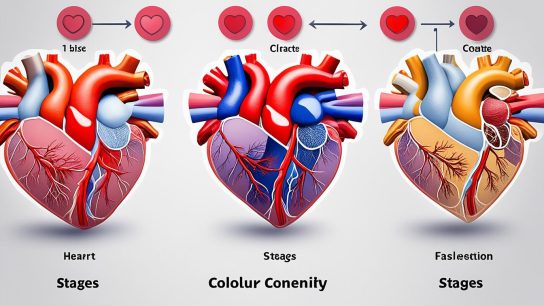Orthodontic treatment is a common solution for correcting dental issues such as misaligned teeth, gaps, and bite problems. You might be wondering, “How old do you have to be to get braces?” The ideal age for braces is usually around 12 or 13, when a child’s mouth and jaws are still growing. However, orthodontic treatment can be done at any age, and adult braces are also common.
The age requirement for braces can vary depending on individual circumstances and the recommendation of an orthodontist. Children or teenagers who have teeth alignment or bite issues can start orthodontic treatment at an earlier age. On the other hand, adults can benefit from braces as well, although the treatment may take longer as the opportunity for improvement is more limited.
It’s important to note that the duration of orthodontic treatment varies for each person. The treatment generally lasts anywhere from 12 months to 2 and a half years, depending on the complexity of the case. Regular visits to the orthodontist every 4 to 10 weeks are necessary to monitor progress and make adjustments to the braces.
Whether you’re a teenager or an adult, braces can help you achieve a straighter and healthier smile. If you’re considering orthodontic treatment, consult with an orthodontist to determine the most suitable age and treatment plan for you.
Why Should You Get Braces?
Orthodontic treatment with braces offers a multitude of benefits, serving various purposes to enhance oral health and overall well-being. Let’s explore the advantages of getting braces:
1. Improved Oral Hygiene and Health
Straight teeth are easier to clean, making it more convenient to maintain proper oral hygiene. With braces, it becomes easier to brush and floss effectively, reducing the risk of tooth decay, gum disease, and other dental issues that can arise from crooked or misaligned teeth.
2. Enhanced Bite Alignment
Braces help correct bite issues, such as overbite, underbite, and crossbite, improving the alignment of your teeth and jaws. This can lead to a more comfortable bite, reducing strain on the jaw muscles and preventing excessive wear on the teeth. Better bite alignment can also help alleviate problems like headaches and TMJ disorders.
3. Aesthetic Benefits
Straight teeth have a significant impact on the overall appearance of your smile. Braces can effectively align crooked teeth, close gaps, and correct overcrowding, resulting in a more aesthetically pleasing smile. By enhancing the alignment and symmetry of your teeth, braces can boost your self-confidence and improve your overall facial harmony.
By addressing dental misalignment and bite issues, braces not only enhance the aesthetics of your smile but also contribute to improved oral health and overall well-being. The long-term benefits of braces extend beyond just appearances, providing you with a healthier, more confident smile for years to come.
How Do You Get Braces?
When a child requires braces, the first step is usually a referral to an orthodontist by their dentist. Orthodontic treatment can only be carried out by registered orthodontists or dentists with additional orthodontic training. The process of getting braces involves several steps:
- The initial consultation: During the first appointment, the orthodontist will examine the patient’s teeth, jaws, and facial structure to determine the need for braces. X-rays, photographs, and impressions may be taken to develop a personalized treatment plan.
- Treatment planning: The orthodontist will analyze the collected information to create a detailed treatment plan tailored to the patient’s specific needs. This includes selecting the most suitable type of braces.
- Fixing the braces: Once the treatment plan is established, the orthodontist or an orthodontic therapist will fix the braces onto the teeth. This involves applying adhesive and attaching brackets to the teeth, followed by threading archwires through the brackets.
- Adjustments and check-ups: Throughout the treatment process, regular visits to the orthodontist are necessary to adjust the braces, tighten wires, and monitor progress. These appointments typically occur every 4 to 10 weeks.
- Orthodontic treatment types: There are various types of braces available. Fixed braces, which consist of metal brackets and wires, are commonly used for NHS treatment in individuals under 18. Clear ceramic braces are also an option for those seeking a more discreet appearance. Removable aligners, such as Invisalign, can be used for certain cases.
Throughout the entire process, the orthodontist plays a crucial role in designing and overseeing the treatment plan. Their expertise ensures that the braces are fixed correctly, and progress is monitored effectively to achieve the desired results.
The Role of an Orthodontist
The orthodontist is a dental specialist who focuses on improving the alignment of teeth and jaws. They undergo extensive training and education beyond dental school to become experts in orthodontic treatment. Their role includes:
- Evaluating and diagnosing dental and facial irregularities that require orthodontic treatment.
- Developing a customized treatment plan based on the patient’s needs.
- Fixing braces and other orthodontic appliances and ensuring they are correctly positioned.
- Monitoring the progress of the treatment and making necessary adjustments.
- Providing guidance on oral hygiene practices and maintenance during orthodontic treatment.
Orthodontists have the knowledge and skills to address complex orthodontic cases and ensure optimal outcomes.
| Orthodontic Treatment Types | Description |
|---|---|
| Fixed braces | Consist of metal brackets and wires attached to the teeth. Often used for NHS treatment in individuals under 18. |
| Clear ceramic braces | Similar to fixed braces but made of tooth-colored ceramic material for a more discreet appearance. |
| Removable aligners | Transparent, custom-made trays (e.g., Invisalign) that gradually move the teeth into proper alignment. |
Different Types of Braces
When it comes to orthodontic treatment, there are various types of braces available to suit different needs and preferences. Let’s explore the different options:
1. Metal Braces
Metal braces are the most common type of braces and are often used for NHS treatment. They consist of stainless steel brackets that are bonded to the teeth and connected by wires. Metal braces are highly effective in correcting various orthodontic issues.
2. Ceramic Braces
Ceramic braces are similar to metal braces but with tooth-colored or clear brackets. This makes them less noticeable compared to metal braces. However, ceramic braces tend to be more fragile and require extra care to avoid any breakage.
3. Lingual Braces
Lingual braces are a discreet option as they are placed on the back surfaces of the teeth, making them virtually invisible. These braces are custom-made and provide effective treatment while maintaining a natural smile.
4. Self-Ligating Braces
Self-ligating braces have a unique design that eliminates the need for elastic or metal ties to hold the archwire in place. These braces use special brackets with built-in clips to secure the wire, allowing for smoother adjustments and potentially shorter treatment times.
5. Clear Aligners
Clear aligners, such as Invisalign and ClearCorrect, are a popular choice for those seeking a more discreet orthodontic treatment. These aligners are made of transparent plastic and are removable, offering flexibility and convenience while straightening teeth.
How Old Do You Have to Be to Get Braces?
Orthodontic treatment, including braces, can be a transformative experience for individuals of all ages. While the ideal age for braces is typically around 12 or 13 years old when a child’s mouth and jaws are still growing, it’s important to note that orthodontic treatment can be started earlier or later depending on individual circumstances.
Orthodontic treatment in children aims to guide the growth and development of the teeth and jaws, correcting any alignment or bite issues early on. Treating these issues at a younger age can lead to more predictable and efficient results. It’s commonly recommended to have an initial orthodontic evaluation around the age of 7 to identify any potential issues that may benefit from early intervention.
However, it’s never too late to consider braces. Adults can also benefit from orthodontic treatment, although the opportunity for improvement may be more limited due to the completion of growth. Adult orthodontic treatment often takes longer compared to that of children since mature bone is less responsive to movement.
Ultimately, the best age for braces depends on the individual’s specific needs and the recommendation of an experienced orthodontist. By addressing orthodontic issues at the most appropriate time, individuals can achieve optimal results and enjoy the benefits of a healthy, functional, and confident smile.
Benefits of Orthodontic Treatment at a Younger Age
Orthodontic treatment in children has several advantages. By starting treatment at a younger age, orthodontists can:
- Guide the growth of the jaws to create a more harmonious facial profile
- Correct bite problems, such as overbite, underbite, and crossbite, which can impact proper chewing and speech development
- Prevent the need for more extensive treatment, such as jaw surgery, in the future
- Ensure sufficient space for the eruption of permanent teeth, reducing the need for tooth extractions
- Improve dental and facial aesthetics, leading to enhanced self-confidence and social well-being
Orthodontic Treatment Options for Children
When it comes to orthodontic treatment in children, there are various options available, including:
| Treatment Option | Description |
|---|---|
| Metal braces | Durable and cost-effective, these traditional braces use metal brackets and wires to gradually move the teeth into proper alignment. |
| Ceramic braces | Similar to metal braces but with tooth-colored ceramic brackets, offering a more discreet appearance. |
| Lingual braces | Braces placed on the back surfaces of the teeth, making them virtually invisible from the front. |
| Clear aligners | Removable and transparent aligners, such as Invisalign, that gradually move the teeth without the need for brackets or wires. |
During an initial consultation, an orthodontist will evaluate the child’s specific dental needs and recommend the most appropriate treatment option.

Cost of Braces
The cost of braces can vary depending on the type of braces and location. Generally, the cost range for braces is between $3,000 and $10,000. Metal braces are typically more affordable compared to ceramic braces, lingual braces, and clear aligners.
If you’re considering getting braces, it’s important to check with your dental or health insurance provider as some plans may cover orthodontic treatment for children but not adults. Understanding your coverage can help you plan for the cost of braces.
Supplemental orthodontic insurance or payment plans may also be available to make braces more affordable. These options can help you spread out the cost of treatment over time, making it more manageable for your budget.
In addition to the upfront cost of braces, it’s important to consider any other associated expenses such as regular visits to the orthodontist, X-rays, and potential adjustments or repairs. These costs should be factored into your budget to ensure you can comfortably afford orthodontic treatment.
When determining the overall cost of braces, keep in mind that prices may vary depending on your location. Orthodontic practices in urban areas or areas with a higher cost of living may charge more for their services compared to practices in rural areas.
Average Cost of Different Types of Braces
| Type of Braces | Cost Range |
|---|---|
| Metal Braces | $3,000 – $7,000 |
| Ceramic Braces | $4,000 – $8,000 |
| Lingual Braces | $8,000 – $10,000 |
| Clear Aligners | $4,000 – $8,000 |
As you can see from the table, the cost range for each type of braces can differ. It’s important to consult with your orthodontist to determine the most suitable option for your specific needs and budget.
In summary, the cost of braces can vary depending on factors such as the type of braces, location, and additional expenses. Checking your insurance coverage, exploring supplemental insurance options, and considering payment plans can help make braces more affordable. Remember to budget for regular visits and potential adjustments throughout the duration of your orthodontic treatment.
Insurance Coverage for Braces
When it comes to insurance coverage for braces, it’s important to know that each plan varies. In general, most health insurance plans do not cover orthodontic treatment for adults, but they may provide partial coverage for children under 18. Dental insurance plans also differ in their coverage for braces.
Medicaid is a government program that provides health care coverage for individuals and families with limited income. Medicaid coverage for braces may be available if the treatment is deemed medically necessary. It’s important to check with your specific Medicaid plan to understand the eligibility criteria and coverage details.
Supplemental orthodontic insurance is an option for those who require additional coverage for braces. This type of insurance can be purchased separately to help offset the cost of orthodontic treatment. It’s important to review the terms and conditions of the insurance policy to ensure it provides the necessary coverage for your specific needs.
In addition to insurance, there are other options available to help make braces more affordable. Some individuals may have a health savings account (HSA), flexible spending account (FSA), or medical savings account (MSA) which can be used to cover the cost of braces. These accounts allow you to set aside pre-tax dollars specifically for medical expenses, including orthodontic treatment.
It’s important to understand the coverage and limitations of your insurance plan when it comes to braces. Keep track of expenses related to orthodontic treatment as they may be eligible for tax deductions. Consult with your insurance provider or a tax professional to fully understand the potential deductions and requirements.

Maintenance and Care with Braces
Proper maintenance and care are essential when wearing braces. Caring for braces and practicing good oral hygiene with braces not only prevents tooth decay and gum disease but also ensures the success of your orthodontic treatment. Here are some important tips to keep in mind:
1. Cleaning Teeth with Braces
It is crucial to maintain a regular brushing routine while wearing braces. Brush your teeth after every meal using a soft-bristled toothbrush and fluoride toothpaste. Pay extra attention to cleaning around the brackets and wires to remove any food particles or plaque buildup. Consider using an interdental brush or floss threader to clean between the teeth and braces. Effective cleaning will help keep your teeth healthy throughout the treatment.
2. Using Retainers After Braces
After your braces are removed, wearing retainers is necessary to maintain the results and prevent your teeth from shifting back to their original positions. Your orthodontist will provide specific instructions on how often and for how long you should wear your retainers. Make sure to clean your retainers regularly using a gentle retainer cleanser or mild soap and warm water.
3. Diet During Braces
During orthodontic treatment, it is important to be mindful of your diet to avoid damaging your braces. Stay away from sticky and chewy foods like gum, caramel, and taffy, as they can get stuck and cause brackets or wires to loosen. Also, minimize your consumption of hard foods such as ice, nuts, and hard candies that can break or dislodge the braces. Opt for softer foods that are braces-friendly, like mashed potatoes, yogurt, soups, and cooked vegetables. Maintaining a healthy diet will keep both your teeth and braces in good shape.
4. Regular Orthodontic Visits
Don’t forget to attend your scheduled orthodontic visits during your treatment. These visits are essential for adjustments, monitoring progress, and addressing any concerns you may have. Follow your orthodontist’s instructions and ask any questions related to caring for your braces or maintaining oral hygiene.
By following these tips for caring for braces and practicing good oral hygiene, you can ensure the success of your orthodontic treatment and achieve a healthy, beautiful smile. Remember, the effort you put into maintaining your braces will pay off in the long run!
Refusal of NHS Braces
While NHS orthodontic treatment offers braces for young people under 18 if deemed necessary, it’s important to note that not all children will qualify for this option. If a child is denied NHS braces, there are steps that can be taken to address the situation.
Firstly, it is recommended to discuss the situation with the child’s dentist. The dentist can provide further insights and possibly offer alternative solutions to meet the child’s orthodontic needs.
If dissatisfaction persists or if the dentist is unable to provide a satisfactory resolution, it is suggested to contact the NHS regional team in England. They can provide additional assistance and guidance on the next steps to take.
It’s important to remember that private treatment is also an alternative option for those who are denied NHS braces. However, it’s essential to understand that private treatment may come with additional costs and should be carefully considered.
Alternative Options for Braces
If NHS braces are not available or feasible, there are alternative options to consider. These alternatives may include:
- Private orthodontic treatment: Private orthodontists offer a wide range of braces options, such as metal braces, ceramic braces, or clear aligners. While this option may require additional financial investment, it allows for greater flexibility in treatment choices.
- Payment plans: Many orthodontic offices offer payment plans to distribute the cost of braces over time. This can help make the expense more manageable.
- Orthodontic insurance: Supplemental orthodontic insurance can be purchased to help cover the cost of braces. It’s important to carefully review the coverage options and limitations of such insurance plans.
- Dental schools: Dental or orthodontic schools often offer reduced-cost orthodontic treatment under the supervision of experienced professionals. While the treatment may take longer, it provides an opportunity to receive treatment at a more affordable price.
Exploring these alternative options and discussing them with the child’s dentist can help find the most suitable course of action if NHS braces are denied.
| Option | Benefits | Considerations |
|---|---|---|
| Private orthodontic treatment | Greater treatment flexibility, various brace options | Higher cost, may not be covered by insurance |
| Payment plans | Allows for spreading the cost of braces over time | May accrue interest or additional fees |
| Orthodontic insurance | Financial assistance for braces | Coverage limitations, cost of premiums |
| Dental schools | Reduced-cost treatment under professional supervision | Treatment may take longer, limited appointment availability |

It’s important to explore all available options and carefully weigh the benefits and considerations before making a decision. Every individual’s orthodontic journey is unique, and finding the right solution is crucial for achieving a healthy and confident smile.
Making Braces More Affordable
For many individuals, the cost of braces can be a significant concern. However, there are several strategies that can help make orthodontic treatment more affordable.
1. Payment Plans for Braces
Many orthodontic offices offer payment plans, which allow you to distribute the cost of braces over time. This can help alleviate the financial burden and make the expense more manageable. By spreading out the payments, you can budget accordingly and have greater flexibility in meeting the cost of treatment.
2. Dental Schools for Reduced Cost Braces
Another option to consider is seeking orthodontic treatment at dental or orthodontic schools. These schools often provide services at reduced costs under the supervision of experienced professionals. While there may be longer wait times and a little less convenience, it can be an excellent way to obtain quality treatment at a more affordable price.
3. Orthodontic Insurance
Exploring orthodontic insurance options is also crucial in reducing the overall cost of braces. Some dental insurance plans offer coverage for orthodontic treatment, ensuring that a portion of the expenses is taken care of by the insurance provider. It is essential to review your insurance policy to determine the extent of coverage for orthodontic treatment.
4. Planning Ahead for Braces
Planning ahead and budgeting for braces can also make the financial aspect more manageable. By anticipating the expense, you can save up or set aside funds specifically for orthodontic treatment. Proper financial planning can help alleviate stress and ensure that the necessary funds are available when needed.
5. Oral Care with Braces
Taking excellent care of your oral health while wearing braces is essential in preventing any additional costs or complications. This includes using an electric toothbrush and specialized brush heads to clean your teeth thoroughly. Flossing regularly and using interdental brushes or water flossers helps remove plaque and food debris around the brackets and wires. Proper oral care not only promotes oral health but also reduces the risk of developing issues that may require additional dental treatment.
By considering these approaches, you can make braces more affordable and attain the beautiful smile you desire.
Comparison of Affordability Strategies for Braces
| Strategy | Description | Advantages |
|---|---|---|
| Payment Plans | Distribute the cost of braces over time | Flexible payments, manageable financial burden |
| Dental Schools | Receive treatment at reduced costs in education institutions | Lower prices, quality treatment under supervision |
| Orthodontic Insurance | Utilize insurance coverage for orthodontic treatment | Financial relief, reduced out-of-pocket expenses |
| Planning Ahead | Budget and save specifically for braces | Financial preparedness, peace of mind |
| Oral Care | Maintain good oral hygiene during orthodontic treatment | Preventative care, minimize additional dental expenses |
Conclusion
Orthodontic treatment with braces is a versatile option that can benefit individuals of all ages. While the ideal age to start braces is typically around 12 or 13, it is important to note that treatment can be done earlier or later depending on individual needs and circumstances. The type of braces and cost may vary, so it is essential to consult with an orthodontist to determine the best option for you or your child. Considering insurance coverage is also crucial to manage expenses effectively.
In addition to maintaining proper maintenance, care, and oral hygiene, it is worth exploring alternative options and seeking assistance to make braces more affordable. Many orthodontic offices offer payment plans to help distribute the cost over time, and dental or orthodontic schools may provide reduced-cost services under professional supervision. Planning ahead to budget for braces can also ease the financial burden.
Orthodontic treatment with braces aims to enhance the alignment of teeth and bite, resulting in improved overall oral health. By addressing issues such as crooked or misaligned teeth, gaps, and bite problems, braces can help create a healthier and more confident smile. Whether you are considering braces for yourself or your child, the importance of orthodontic treatment cannot be overstated. Consult with an orthodontist to determine the best course of action, and embrace the journey toward a straighter, healthier smile.




